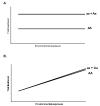Gene-environment interactions in sarcoidosis: challenge and opportunity
- PMID: 17560304
- PMCID: PMC1920704
- DOI: 10.1016/j.clindermatol.2007.03.005
Gene-environment interactions in sarcoidosis: challenge and opportunity
Abstract
Susceptibility to most human diseases is polygenic, with complex interactions between functional polymorphisms of single genes governing disease incidence, phenotype, or both. In this context, the contribution of any discrete gene is generally modest for a single individual, but may confer substantial attributable risk on a population level. Environmental exposure can modify the effects of a polymorphism, either by providing a necessary substrate for development of human disease or because the effects of a given exposure modulate the effects of the gene. In several diseases, genetic polymorphisms have been shown to be context dependent, ie, the effects of a genetic variant are realized only in the setting of a relevant exposure. Because sarcoidosis susceptibility is dependent on both genetic and environmental modifiers, the study of gene-environment interactions may yield important pathogenetic information and will likely be crucial for uncovering the range of genetic susceptibility loci. The complexity of these relationships implies, however, that investigations of gene-environment interactions will require the study of large cohorts with carefully defined exposures and similar clinical phenotypes. A general principle is that the study of gene-environment interactions requires a sample size at least severalfold greater than for either factor alone. To date, the presence of environmental modifiers has been demonstrated for one sarcoidosis susceptibility locus, HLA-DQB1, in African-American families. This article reviews general considerations obtaining for the study of gene-environment interactions in sarcoidosis. It also describes the limited current understanding of the role of environmental influences on sarcoidosis susceptibility genes.
Figures






Similar articles
-
A Gene-Environment Interaction Between Smoking and Gene polymorphisms Provides a High Risk of Two Subgroups of Sarcoidosis.Sci Rep. 2019 Dec 9;9(1):18633. doi: 10.1038/s41598-019-54612-1. Sci Rep. 2019. PMID: 31819081 Free PMC article.
-
HLA and environmental interactions in sarcoidosis.Sarcoidosis Vasc Diffuse Lung Dis. 2008 Dec;25(2):125-32. Sarcoidosis Vasc Diffuse Lung Dis. 2008. PMID: 19382531
-
The investigation of HLA microsatellites influence in predisposition to sarcoidosis among Croatians.Sarcoidosis Vasc Diffuse Lung Dis. 2011 Jul;28(1):18-26. Sarcoidosis Vasc Diffuse Lung Dis. 2011. PMID: 21796887
-
Review: role of genetics in susceptibility and outcome of sarcoidosis.Semin Respir Crit Care Med. 2010 Aug;31(4):380-9. doi: 10.1055/s-0030-1262206. Epub 2010 Jul 27. Semin Respir Crit Care Med. 2010. PMID: 20665388 Review.
-
Genetics of sarcoidosis.Clin Dermatol. 2007 May-Jun;25(3):242-9. doi: 10.1016/j.clindermatol.2007.03.001. Clin Dermatol. 2007. PMID: 17560301 Review.
Cited by
-
Treatment of Granulomatous Inflammation in Pulmonary Sarcoidosis.J Clin Med. 2024 Jan 27;13(3):738. doi: 10.3390/jcm13030738. J Clin Med. 2024. PMID: 38337432 Free PMC article. Review.
-
Sarcoidosis and its otolaryngological implications.Eur Arch Otorhinolaryngol. 2010 Oct;267(10):1507-14. doi: 10.1007/s00405-010-1331-y. Epub 2010 Jul 9. Eur Arch Otorhinolaryngol. 2010. PMID: 20617327 Review.
-
The interaction of early life factors and depression-associated loci affecting the age at onset of the depression.Transl Psychiatry. 2022 Jul 25;12(1):294. doi: 10.1038/s41398-022-02042-5. Transl Psychiatry. 2022. PMID: 35879288 Free PMC article.
-
Meta-analysis of genetic programs between idiopathic pulmonary fibrosis and sarcoidosis.PLoS One. 2013 Aug 14;8(8):e71059. doi: 10.1371/journal.pone.0071059. eCollection 2013. PLoS One. 2013. PMID: 23967151 Free PMC article.
-
An American Thoracic Society Official Research Statement: Future Directions in Lung Fibrosis Research.Am J Respir Crit Care Med. 2016 Apr 1;193(7):792-800. doi: 10.1164/rccm.201602-0254ST. Am J Respir Crit Care Med. 2016. PMID: 27035782 Free PMC article.
References
-
- Hunninghake GW, et al. ATS/ERS/WASOG statement on sarcoidosis. American Thoracic Society/European Respiratory Society/World Association of Sarcoidosis and other Granulomatous Disorders. Sarcoidosis Vasc Diffuse Lung Dis. 1999;16(2):149–73. - PubMed
-
- Martinetti M, et al. “The sarcoidosis map”: a joint survey of clinical and immunogenetic findings in two European countries. Am J Respir Crit Care Med. 1995;152(2):557–64. - PubMed
-
- Iannuzzi MC, et al. Sarcoidosis Susceptibility and Resistance HLA-DQB1 Alleles in African Americans. Am J Respir Crit Care Med. 2003;167(9):1225–31. - PubMed
-
- Rybicki BA, et al. Sarcoidosis and granuloma genes: a family-based study in African-Americans. Eur Respir J. 2004;24(2):251–7. - PubMed
Publication types
MeSH terms
Substances
Grants and funding
LinkOut - more resources
Full Text Sources
Medical
Research Materials

